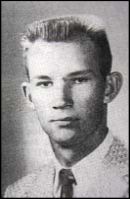held 100-125 bushels. By 2007, it wasn't called a big wagon unless it held 600, perhaps 700, or more bushels.
Another thing that is no longer used on the farm of the current time is the windmill. This entire farm, at the time, could be supplied with water from the windmill if the need arose although there was an electric powered well that supplied the house and the automatic water fountain to the livestock.
East (right) of the garage, hardly visible in this photo, was a large garden with a small raspberry patch. North of the house was an orchard of plum, apple, and cherry trees. An orchard, large or small, was one of the first things a farmer planted to help supply a self-sufficiency to the farm.
Another thing that is not visible in the photo is the change in the plant population at planting time. Starting at the end of the War planting populations edged up from 1315,000 until by the turn of the century, few were planting at less than 30,000 corn kernels an acre.
Another practice, unseen in the photo, would be the use of a crop rotation such as a corn, corn, oats, hay (or pasture) covering a four year period. Gradually the second year corn disappeared with soybeans replacing the second year corn. By the late sixties, most farmers were alternating back and forth between corn one year and soybeans the following.
As a footnote to an inflation factor, the barn was built in 1948 for a total cost of less than $12,000; and that included tearing down the old barn. In 2003, two of the three roof surfaces were reshingled with wood shingles at a cost of over $16,000.
Also, corn was sold in the spring of 1948 for $2.17 delivered to Roland and in the summer of 2006, it's hovering around the $1.85 mark. Yields have increased significantly from the time of the fifties to the present. In the early fifties, if a farmer got 100 bpa, he could be quite proud, however, by the turn of the century, 100 bpa would be considered a “crop failure” with yields approaching, and occasionally passing, the 200 bpa figure for a farm average.
In the early fifties, Roy Borton, 2 miles east and 1 1/2 mile north of Milford School, had a Crow's Seed Corn dealership and when his farm averaged 104 Bushels per Acre, Crow's Seed Company, headquartered in Nevada, Iowa and Milford, Illinois, ran a full page ad in the farm magazines announcing that an Iowa farmer, using Crow's Hybrids, of course, had exceeded 100 bpa for an all farm yield.
At that time, when companies desired to raise corn for seed, the job, which supplied employment and money to many of the young people, required the “detasseling” to be done by hand. Currently, machines do the job and if any hand labor is used, it is just for “clean up”.
In Sept 1976, in a different type of dangerous activity, a Milford farmer was arrested for growing marijuana. He apparently was taking good care of the plants because the Sheriff arrested the Milford farmer when he showed up to water the plants. Another Milford farm described on page 339.
When one thinks of the farming occupation, one does not have a tendency to dwell on the possible dangers involved with this occupation. It is much more pleasant to reflect on the beautiful waving grain stirred by a gentle summer breeze. However, since the War, there have been seven farmers killed in Milford Twp by their occupation. These are:
-Farrel Safly; Squeezed between tractor and barn.
-Don Radabaugh; Tractor upset while herding cows in 1960. He was in the class of 1963.
-LaVerne Jacobson`35; Fell off a tractor while disking. 1969
-Janice Radabaugh Borton`61; Tractor upset hauling wagons. 1969. See also 72 and 205.
-Rex Hughes (Jr); Suffocated in moving grain in large wagon. Nov 1985. He was in the class of `92.
-Max Arrasmith`32; Loader tractor upset while load- ing a wagon. 1989
-Marvin Smith III`65; Fell from a loader bucket onto concrete. June 2002
-Marvin Smith II (Jr.) `41N; died in Peru in Jan of 1974 while on a farm tour. He was 51 years of age.
-Craighten Kaltenhauser`71R, former Milfordite, son of Frank, while living near Lusk, WY in the 1980s, was killed when repairing a truck PTO.

One time, a number of years ago, I stood with a neighbor, Bob Jacobson `57, (A man who has probably farmed in Milford longer than anyone except Leo Tjelmeland) in a machine shed on a pleasant rainy afternoon and he and I were reflecting on how many of our neighbors had been injured with farm accidents. He, knowing the farmers within the community better than I, just “went up and down the roads” naming the fellows, (he included most of the them) and mentioned the permanent injuries that so many of them carried and lived with. They were all the way from a finger and fingernai l being split open by an auger, to the loss of fingers, to the uneven leg length of a neighbor who had a leg broken in a power takeoff accident and it never healed correctly.
Boyd Brodie `81N, 13 year old son of Duane `56 and Barbara `57 (Sorem) Brodie, had the lower portion of his left leg taken off when injured by an auger at the family farm while emptying a grain bin. This occurred on 13 July 1976.
Paul Comfort, north of the School 1 1/4 mile, lost three fingers in a corn picking accident in early Nov of 1959.
J E Fausch, oldest son of Richard, was critically injured in a farm accident on 10 May 1929. By Dale Hughes